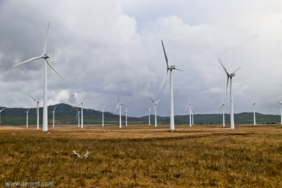The report Wind energy in Europe in 2018, published in February 2019 by the non-profit association WindEurope, provides annual trends and statistics on European wind farms and discusses new installations and financial activities in the industry in 2018. The report analyses both the 28 members of the EU and other countries of the continent, taking into account onshore and offshore as installations, as well as decommissioned wind turbines, and provides numbers on the total cumulative capacity of each country.
In 2018 wind installations in Europe fell to 11.7 GW. This is a dramatic 32% drop compared to 17.1 GW in 2017 (a wind energy record year in Europe), even though in 2018 wind power became a leading energy technology in the EU, accounting for 49% of all new installations. Wind energy also covered 63% of Europe’s investments in renewable energy in 2018, compared to 52% in 2017. Europe decommissioned 0.4 GW of wind turbines, mainly in the onshore wind sector. Generally speaking, 2018 was the worst year for new onshore turbines since 2008.
According to the report, 86% of total wind power in the whole of Europe was generated by EU member states and 65% by just four countries, Germany, the UK, France and Sweden. Despite a significant fall in onshore installations (2,402 MW compared to 5,334 MW in 2017), Germany remains the leader with 3,370 MW of installations, which account for 29% of new wind energy. In second position is the United Kingdom (1,900 MW), with the Walney 3 Extension offshore wind farm completed in October being the largest operational offshore wind farm in the world. France (1,565 MW) with 13% of new installations, is the third biggest wind market.
Outside the EU, Turkey, Norway and Serbia are leading the way, each having new installations between 350 and 500 MW. 14 countries, for example Hungary, Bulgaria and Switzerland, did not have any new wind installations in 2018.
It’s worth mentioning that wind energy generated in 2018 covered 14% of the EU’s electricity demand (2% higher than in 2017). Denmark is the champion in this area, covering 41% of its average annual electricity demand by wind power. It is followed by Ireland (28%), Portugal (24%) and Germany (21%).
If we look at the total cumulative capacity, the top five countries in this category are Germany (59 GW ), Spain (23 GW), the UK (21 GW), France (15 GW) and Italy (10 GW). It is interesting to note that Malta is at the bottom of the league when it comes to wind power as it is the only country in Europe that does not have significant wind installations.
In general, wind energy is the second largest form of power generation capacity in the EU, with a total installed capacity of 178.8 GW (160 GW – onshore, 18.5 GW – offshore). According to the forecasts by WindEurope, wind power installations are expected to overtake natural gas installations in 2019.
